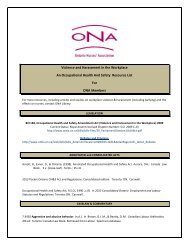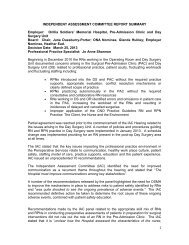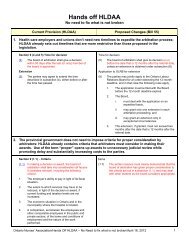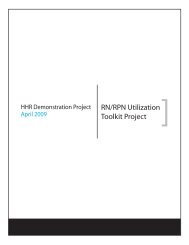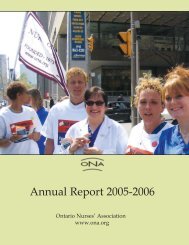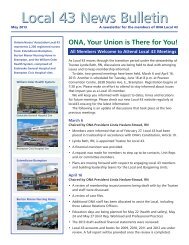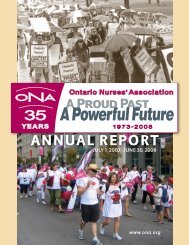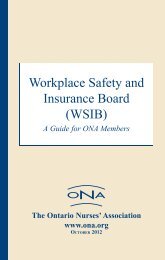Hallway Nursing/ER Overcapacity - Ontario Nurses' Association
Hallway Nursing/ER Overcapacity - Ontario Nurses' Association
Hallway Nursing/ER Overcapacity - Ontario Nurses' Association
Create successful ePaper yourself
Turn your PDF publications into a flip-book with our unique Google optimized e-Paper software.
December 2007Position Statement<strong>Hallway</strong> <strong>Nursing</strong>/<strong>ER</strong> <strong>Overcapacity</strong>The <strong>Ontario</strong> Nurses’ <strong>Association</strong> (ONA) has long heldthe belief that health care employers must provide aquality work environment that allows nurses to care forpatients according to best practices and to meet theCollege of Nurses of <strong>Ontario</strong> (CNO) standards. Webelieve hospital overcapacity protocols that result inhallway nursing put patients and nurses at increasedrisk and must be stopped.We recognize the overcrowding and long wait timesthat exist in hospital emergency units across theprovince. Emergency Room (<strong>ER</strong>) overcapacity is havinga negative impact on the ability of registered nursesto meet <strong>ER</strong> triage standards. This situation is thedirect result of a lack of government funding for hospitalbeds and sufficient staff to allow patients to beadmitted to hospital or transferred to long-term care orhome care. The solution to this funding problem is notto have nurses manage more patients without appropriatesupports in unsafe environments such as hallways.The lack of privacy, physical space, proper supplies,equipment and nurse staffing negatively affectpatient safety and health outcomes.<strong>Hallway</strong>s provide little privacy or dignity and thismakes development of a therapeutic relationship withpatients and families next to impossible. Nurses arenot able to practice to the best of their ability andtherefore must advocate for client safety and their professionalpractice, as required by the following CNOstandard:Every nurse is accountable for:• Providing, facilitating, advocating and promoting thebest possible care for clients.• Advocating for patients, the profession and thehealth care system.• Ensuring practice is consistent with standards ofpractice, guidelines and legislation.• Taking action in situations where client safety andwell-being are compromised.Administrative nurses have accountability to thepatients and other nurses on the unit to provide a qualitypractice setting and to staff it in the best interest ofclients and professional practice. Allowing hallwaynursing appears to be in direct conflict with what isexpected of an administrative nurse by the CNO standardsas follows:• In addition, a nurse in an administrative role isaccountable for:• Ensuring that mechanisms allow for staffingdecisions that are in the best interest ofpatients and professional practice.• Ensuring appropriate utilization, education andsupervision of staff.• Advocating for a quality practice setting thatsupports nurses’ ability to provide safe, effectiveand ethical care.Research tells us that inadequate nurse staffing isconsidered one of the work conditions that precipitateerrors and violations of standards, increased nurseinjuries and that adding one patient to a nurse’s averagecaseload in acute care hospitals is associatedwith increases of failure to rescue by 7 per cent,patient mortality by 7 per cent, nurse burnout by 23 percent and job dissatisfaction by 15 per cent. (Aiken etal. 2002. “Hospital Nurse Staffing and Patient Mortality,Nurse Burnout, and Job Dissatisfaction.” Journal ofthe American Medical <strong>Association</strong>. Vol. 288, No.16.)An adverse event is an unintended injury or complicationwhich results in disability, death or prolonged hospitalstay, and is caused by health care management(rather than by the patient’s underlying condition). In2004, according to the Canadian Adverse EventsStudy, 7.5 per cent of Canadian patients admitted toacute care experienced adverse events and between9,000 and 24,000 patients die annually following a preventableadverse event in hospital. These numberswill only climb with the implementation and/or continuanceof hallway nursing.
ONA opposes the current trend in hospitals to implementthe practice of hallway nursing as it increasesthe risk to patients and nurses. We believe the basicprinciple of do no harm by providing safe, quality careis at risk.• Increase number of general practitioners to addressproblem of patients without family physicians.• Invest in community non-urgent care, which is publiclyfunded, administered and delivered.• Invest in illness prevention.ONA calls upon the <strong>Ontario</strong> government to implementappropriate solutions and take action to eliminateovercapacity protocols that result in hallway nursing.These solutions include:• Fund public home care, long-term care and hospitalsto meet the current realities of patient demographics.• Utilize nurse practitioners in <strong>ER</strong>.• Increase supports in the community (such asincreased use of nurse practitioners).THE ONTARIO NURSES' ASSOCIATION IS THE UNION REPRESENTING REGIST<strong>ER</strong>EDNURSES AND ALLIED HEALTH PROFESSIONALS WORKING IN HOSPITALS, LONG-T<strong>ER</strong>M CAREFACILITIES, PUBLIC HEALTH AND COMMUNITY AGENCIES, INDUSTRY AND OTH<strong>ER</strong>SETTINGS ACROSS ONTARIO.



